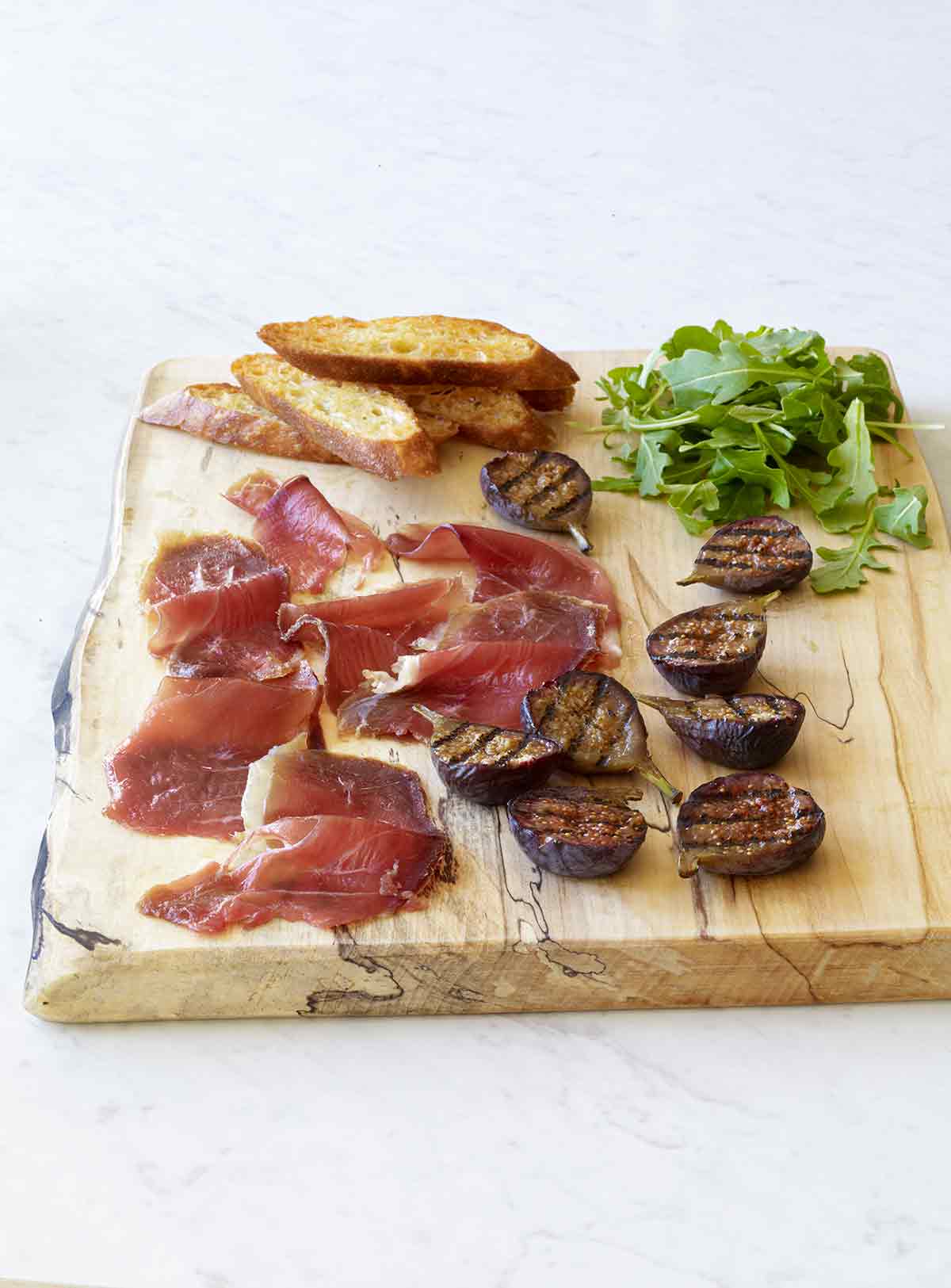
This duck prosciutto recipe began with my realization that what makes ham taste like itself has less to do with the meat than its cure. My quest for kosher prosciutto—nothing less!—led me first to smoked turkey leg, which is hammy all right, but hardly like the Italian specialty. I went to work, and, happily, scored a triple bull’s-eye by giving duck breast a really easy salt cure—just fifteen minutes of prep followed by a “set-it-and-forget-it” refrigerator stay. The resulting “prosciutto” is so much like the real thing, but with a special character all its own, you’ll be amazed. Try it draped atop sliced melon, wrapped around asparagus spears, stirred into creamy tortellini with peas, or diced and sautéed as a salad garnish.–Geila Hocherman and Arthur Boehm
LC Ducking Duct Tape Note
Glance at this unassuming duck prosciutto recipe, and you may notice something rather unusual, aside from the fact that it calls for making prosciutto out of duck rather than pig. Yup. It relies on that handy dandy, every man’s favorite tool kit mainstay, duct tape. Not as an ingredient, as a means of hoisting the duck from the top of the refrigerator where it needs to dangle for a couple of weeks. If you’re not the duck, er, duct tape type, you can follow the inspired lead of one of our recipe testers, Jo Ann Brown. When Brown was getting ready to hang the meat in the fridge, she sent her husband out to find, in her words, “a super duper suction cup with a hook to hang the meat from.” Not only did he find what she wanted, he brought back two. What a keeper!
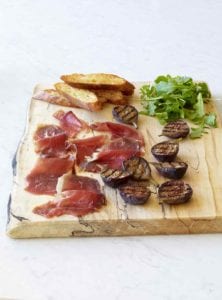
Duck Prosciutto
Ingredients
- One (6- to 8-ounce) duck breast
- 4 cups kosher salt
- 1/2 teaspoon ground coriander
- 1/2 teaspoon ground fennel
- 1/2 teaspoon freshly ground black pepper
- 1 cup white wine vinegar
- 1 medium cantaloupe, galia or honeydew melon, rind removed, sliced 1-inch thick, or several figs (optional)
Instructions
- To make the duck prosciutto, rinse the breast and dry it with paper towels. Scrounge through your cupboards until you find a dish just large enough to hold the duck breast. Make a 1-inch bed of salt on said dish. Place the breast on the salt and cover it with another inch of salt. Cover the entire situation with plastic wrap and refrigerate for 24 to 48 hours.
- In a small bowl, combine the coriander, fennel, and pepper. Unwrap the duck breast and, holding it over the sink, rinse it with the vinegar to remove the salt and then rinse it under cold running water. Pat the duck breast completely dry and then rub it all over with the spice mixture.
- Wrap the breast in cheesecloth and knot the cloth at both ends. Using sturdy household tape (duct tape works well), attach one end of the cheesecloth to the top of the refrigerator interior or hang the breast from a high refrigerator shelf. Place a small rimmed plate or dish beneath it. Let the duck cure until it feels firm but not dry, about 2 weeks. Thinner or smaller breasts will take less time. Start checking after a week or so.
- Using a sharp carving knife, slice the duck prosciutto paper thin or as thin as possible. Drape ribbons of the prosciutto onto a plate and serve with the melon or figs. (The very ends of the cured breast will be quite dry. Save them for flavoring soup.)
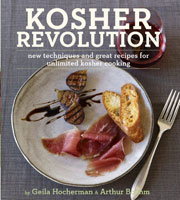
Explore More with AI
Nutrition
Nutrition information is automatically calculated, so should only be used as an approximation.
Recipe Testers’ Reviews
I am so bowled over by this recipe. The duck breast is delicious, tender, and tastes like prosciutto, although not as salty as its pork counterpart (that’s a plus). And the skin, that cured fatty skin, it’s rich and divine like fresh lardo. Most of all, what I LOVE about this recipe, is that I feel like a rock star. I can now cure meat. Really, really good cured meat. How awesome is that?? Ding, Dong, Hello my favorite neighbor, I have some home-cured meat for you — enjoy! ROCK STAR. This recipe is the epitome, the archetype of a great recipe — easy, method works perfectly, delicious product and you feel like a pro. Got to go, I am off to change my Facebook status from “mere mortal” to “home-cure superstar.”
WOW. Finally, an easy way to make prosciutto, even if out of duck, and oddly enough, it tastes just like the real thing. Being Portuguese, that is one thing I must say I miss terribly from back home and certainly cannot afford to be buying on a daily basis. The hardest part now is to have to wait two weeks to taste such a great delicacy. One piece of advice is to make sure not to go over the time recommended for the brine, or you will end up with a very salty prosciutto (learned by mistake!)
Anyone interested in joining the canning and curing renaissance that is gathering steam these days need look no further than this recipe for a perfect jumping-in point. I can’t think of an easier (or tastier) first foray into the world of homemade charcuterie than this lovely duck prosciutto. No special equipment or ingredients are required (such as a smoker or curing salt) for this entry-level curing recipe. With the exception of the duck itself, most well-equipped kitchens will have all that is required to make this dish without a run to the market. As I was lucky enough to have a pekin duck breast from D’artagnan in my freezer, I didn’t even need to run out for that. A critical requirement for making this dish, and one that can’t be bought, is a little patience. While hands-on work with the ingredients takes just a few minutes, the salt cure and dry aging of the breast will take anywhere from nine to 14 days of hands-off waiting. I found my breast perfectly cured with a two-day salt cure and seven-day refrigerated aging period. I’m afraid that leaving it to dry for the full two weeks mentioned as a possibility in the recipe would have left me with duck jerky, not prosciutto. Those of you with kids to help in the kitchen will find them fascinated by the transformation of the fresh breast into cured meat, and with any luck, they’ll enjoy the slightly salty, beautifully seasoned, and unctuously textured treat as much as you do. Serve this gem thinly sliced in a sandwich, on a pizza, with some fresh figs and apples, or as part of a charcuterie or cheese platter. Any way you slice it, this duck is a real winner.
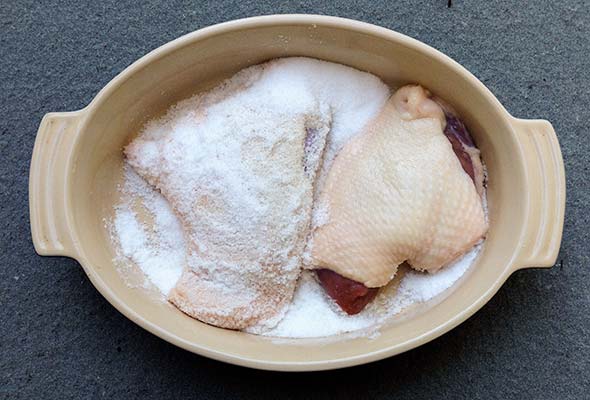
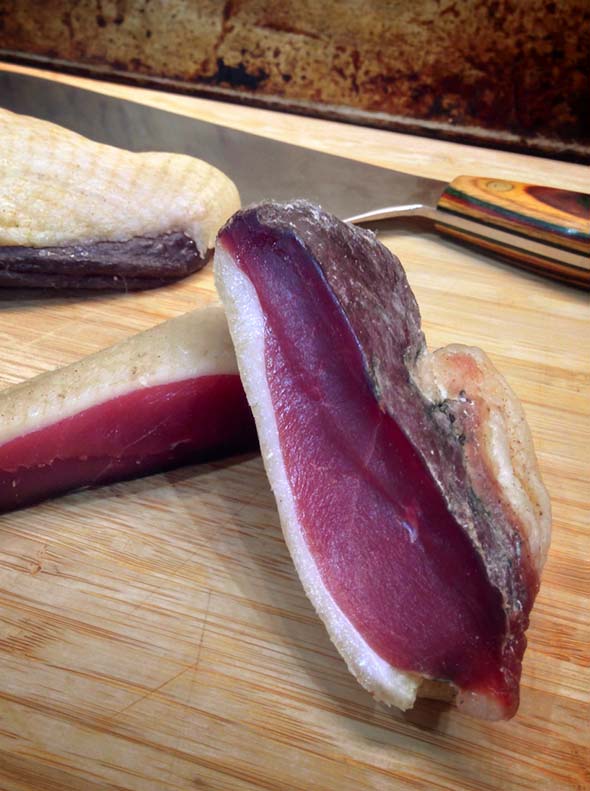


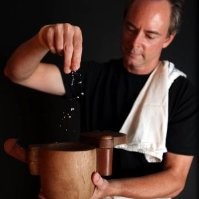










Hi David! This recipe is perfect. I’ve created a recipe that uses Chilean Sea Bass with honeydew and duck prosciutto for my website. There’s no way I could improve upon your recipe and method, so rather than creating one of my own, I’m linking to yours, of course giving you full kudos. I hope that’s ok with you. Regards, Debra
Debra, that sounds absolutely incredible! Chilean sea bass with honeydew and duck prosciutto? That’s some serious culinary creativity. I’m honored that you’re linking to my recipe—thank you for the kudos! I’m putting a link here so folks can see your creation.
Hi! Could I use a deboned duck leg for this?
Jeremy, we didn’t test it that way, but you can try.
In principle, it should work right?
Jeremy, in principle, yes. You need to make sure there are no air holes where bacteria can nestle and bloom. A breast is better because it’s one piece.